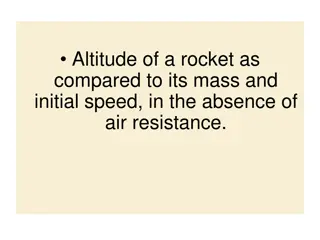Royal Aeronautical Society. Society Outreach Programmes.
Engage with innovative outreach programmes like Cool Aeronautics, Project Altitude, and Falcon 2 offered by the Royal Aeronautical Society to inspire primary and secondary school students in the field of aerospace. Discover opportunities for interactive learning, career exploration, and hands-on exp
0 views • 9 slides
High-Altitude Aeronautical Platform Station Market Trends 2023-2033
The global high-altitude aeronautical platform station (HAAPS) market is estimated to reach $3,338.1 million by 2033 from $1,194.4 million in 2023, growing at a CAGR of 10.82% during the forecast period 2023-2033.\nRead Report Overview: \/\/bisresearch.com\/industry-report\/high-altitude-aeronautica
5 views • 3 slides
VFR Arrival Procedures for Total Solar Eclipse Event on April 8, 2024
In preparation for the Total Solar Eclipse event on April 8, 2024, VFR arrival procedures have been outlined including PPR requirements, assigned arrival windows, entry into Class D airspace, monitoring ADSB for traffic, and altitude/speed assignments for different aircraft types. It is crucial to a
5 views • 30 slides
Mera Peak Climbing
\nMera Peak, standing at 6,476 meters (21,247 feet), is one of the highest trekking peaks in Nepal and offers a non-technical but demanding climb. It is located in the Mahalangur section of the Himalaya, in the Sagarmatha Zone. Mera Peak climbing is a popular choice for mountaineers who want to expe
9 views • 7 slides
Revolutionizing Tertiary Education with ALTITUDE: A Universal Design Initiative
Discover how ALTITUDE is reshaping tertiary education through universal design principles. Gain insights into the policy framework, sectoral commitment, and collaborative efforts driving the project. Learn about the development of the ALTITUDE Charter, strategic foundations, and the significant impa
0 views • 14 slides
Understanding Ozone Depletion: Causes and Impact
The ozone layer, found in the stratosphere at 15 to 40 km altitude, plays a crucial role in absorbing harmful ultraviolet radiation. However, due to the use of Chlorofluorocarbons (CFCs), the ozone layer has been depleted, leading to the formation of the ozone hole. This depletion is caused by chemi
0 views • 27 slides
Climate and Climatic Regions of Pakistan
Pakistan exhibits diverse climatic regions ranging from sub-tropical continental mountains to arid desert plateaus. Factors like altitude, latitude, and distance from the sea greatly influence the country's climate. The country experiences weather conditions such as temperature variations, rainfall
0 views • 14 slides
Understanding Pulmonary Circulation and Its Importance in Respiratory Physiology
Pulmonary circulation, as explained by Professor Narsingh Verma, plays a crucial role in the respiratory system, showcasing distinct differences from systemic circulation. The low pressure and resistance in pulmonary circulation allow for optimal gas exchange at the alveolocapillary membrane. Variou
1 views • 30 slides
Natural Vegetation and Wildlife Sanctuaries in India
The natural vegetation in India varies based on climatic and topographical factors, leading to diverse flora such as Evergreen Rain Forests, Monsoon Deciduous Forests, and Desert ecosystems. The Himalayas showcase vegetation changes with altitude, while factors like soil and topography influence veg
2 views • 39 slides
Exploring Plant Traits: Do Plants Exhibit Variation in Traits?
Discover in this lesson whether plants display variations in traits through the measurement of plant lengths. Students analyze data tables of carrots and leaves to observe trait variations and discuss patterns found in bar graphs and data tables. The focus is on understanding how to identify and int
0 views • 11 slides
Factors Influencing Temperature and Rainfall in Geography Lessons
Factors such as distance from the equator, sea, altitude, ocean currents, winds, and mountains influence temperature and rainfall patterns. Understanding these factors is crucial for geography students to grasp the concepts of climate and weather conditions in different regions. The provided notes e
0 views • 9 slides
Understanding Electronic Flight Instrument System (EFIS)
An Electronic Flight Instrument System (EFIS) replaces traditional flight deck instruments with electronic displays like the Primary Flight Display (PFD) and Multi-Function Display (MFD). EFIS enhances situational awareness for pilots by consolidating critical flight data in a single, easy-to-read i
0 views • 12 slides
Adaptation of Yak and Mithun at High Altitude
Yak and Mithun are domesticated bovids known for their adaptation to high altitudes in the Himalayan region. Yaks, descended from wild yaks, are used for various purposes like transportation, climbing, and trekking. They have specific mating behaviors and unique anatomical modifications for high alt
0 views • 18 slides
Understanding the Spatial and Temporal Distribution of Temperature
The spatial and temporal distribution of temperatures plays a crucial role in determining weather patterns, climates, vegetation zones, and wildlife habitats. Factors such as latitude, altitude, distance from the coast, and prevailing winds influence the distribution of temperature both horizontally
2 views • 5 slides
IWG Measurement Uncertainties: Justification of Impact Quantities
Explore the justification of main impact quantities in IWG Measurement Uncertainties session held on 6th and 7th October 2020. The analysis includes factors such as deviation from centered driving, start of acceleration, speed variations, load variations, background noise, temperature effects on noi
3 views • 25 slides
High-Altitude Physiology and Its Effects on the Human Body
Understanding the impact of high altitudes on human physiology is crucial for aviation and deep-sea activities. Barometric pressures and alveolar oxygen levels change significantly with altitude, leading to hypoxia-related issues. Factors like carbon dioxide and water vapor further affect alveolar o
1 views • 29 slides
Understanding Atmospheric Pressure Variations at Different Altitudes
Atmospheric pressure varies with altitude due to the weight of the air column above. This activity explores how Otto von Guericke's experiments with vacuum systems demonstrate the power of air pressure. Theoretical concepts of atmospheric pressure are discussed, highlighting its relation to gravity
0 views • 28 slides
Principles of Atmospheric Flight in Aeronautics
This material covers essential topics in aeronautics including the physical properties of the atmosphere, standard atmosphere relationships, Mach number theory, lift and drag principles, stability, control, pressure and temperature variations based on location and solar activity, and the Internation
0 views • 22 slides
Understanding Geopotential and Geopotential Height in Atmospheric Thermodynamics
This lecture discusses the concepts of geopotential and geopotential height in atmospheric thermodynamics, including their definitions, significance, and relationship with gravity. It explains how geopotential is a measure of potential energy relative to sea level and how geopotential height serves
0 views • 17 slides
Understanding Barometric Pressure and Its Impact on Altitude
Barometric pressure, also known as atmospheric pressure, is the force exerted by the weight of air on a specific area and varies with altitude. This pressure is crucial in various industries, such as cement production at high altitudes. Learn about how to calculate barometric pressure, its relation
0 views • 37 slides
Deconvolving Snow Cover and Snowfall Passive Microwave Signals
This research focuses on deconvolving snow cover and snowfall passive microwave signals using GPM data. The study employs a data-driven approach to estimate snowfall using a nested K-nearest algorithm and observed irregularities. By analyzing variations in brightness temperatures (Tbs) over snow-cov
0 views • 9 slides
Pathological Differences in Hip Joint Variations: Abnormal Gait Analysis
Understanding pathological gait variations related to hip joint differences is crucial in gait analysis. Excessive sagittal, coronal, and transverse plane motions impact stance and swing phases, leading to deviations in gait patterns. Excess flexion, limited flexion, past retraction, excess adductio
0 views • 13 slides
Understanding Global Ecosystems and Climate Influences
Global ecosystems are defined by dominant vegetation types and are influenced by factors like climate, atmospheric circulation, altitude, relief, and ocean currents. The distribution and characteristics of ecosystems are shaped by global atmospheric circulation patterns, creating distinct belts of v
0 views • 18 slides
Importance of Rock v. MWB [2018] UKSC 24 as Explained by Lord Sumption
The case of Rock v. MWB [2018] UKSC 24 holds significant importance due to the ruling by Lord Sumption and the Supreme Court's decision regarding contract variations. It revolved around a dispute between MWB, a serviced office provider, and Rock Advertising over alleged contractual variations made o
0 views • 12 slides
High Altitude Science Flight Operations Report
Critical observations from recent high altitude science flight operations include aircraft limitations, airspace access challenges, scheduling issues, and procedural concerns. Key points highlight the inability of AV-1 to maneuver storms, communication successes during unexpected events, flight fail
0 views • 11 slides
Importance of Trait Variations in Desert Beetles
Exploring the significance of trait variations among desert beetles, this lesson delves into why variations matter and how they impact survival in the desert environment. Through activities and discussions, students analyze traits, predict beetle survival, and understand the implications of variatio
0 views • 10 slides
Understanding Factors Influencing Temperature Variations in US Cities
Solar zenith angle, location, specific heat, and axial tilt are key factors influencing temperature variations in US cities. Proximity to water bodies, altitude, and latitude also play significant roles. This lab explores why coastal cities experience different temperature patterns compared to inlan
0 views • 8 slides
Developments in Vertical Columns Inference for TEMPO NO2 Algorithm
The development of the TEMPO NO2 algorithm to infer vertical columns from total slant columns involves contributions from various experts, such as Randall Martin, Nick Krotkov, Lok Lamsal, Jintai Lin, Chris McLinden, and Caroline Nowlan. Attention is needed for the removal of stratospheric NO2 and a
2 views • 10 slides
Exploring Layers of Earth's Atmosphere
Earth's atmosphere consists of five major layers, each with unique properties and temperature changes with altitude. The troposphere, closest to the Earth's surface, experiences a temperature decrease with altitude due to heat from the sun and Earth's surface. Learn about the properties of the tropo
0 views • 26 slides
Understanding Pressure, Altitude, and Temperature Activities
Exploring the concepts of pressure, altitude, and temperature through engaging activities like observing air pressure at sea level, experimenting with vacuum chambers and boiling water, and understanding the relationship between force, area, and pressure.
0 views • 9 slides
Exploring Snake Traits and Variations
Delve into the world of snakes to understand their shared traits and diverse variations. Discover how these variations in traits help snakes survive and reproduce, offering insights into their unique characteristics and evolutionary advantages.
0 views • 14 slides
Exploring Bird Variations: A Comparative Study
Dive into the world of bird variations in this informative lesson discussing how birds are alike and different, the importance of traits, and exploring differences among bird species. Discover the concepts of variations and traits through engaging activities and observations.
0 views • 14 slides
Navigating the Seas with a Sextant: Altitude Measurement
Explore the art of measuring altitude using a Davis Mark 3 Marine Sextant. Learn about correcting index errors, taking stellar and solar sights, and reading a sextant for accurate navigation at sea.
0 views • 9 slides
Exploring Membrane Potential Variations in Neural Networks
Delve into the dynamics of membrane potential variations in neural networks through topics like white noise approximation, autocorrelation of Poisson processes, and the Noisy Integrate-and-Fire model. Investigate how these variations manifest at different thresholds, shedding light on the biological
0 views • 63 slides
Impact of Velocity Field Variations on Pulsar Magnetic Fields
The study explores how variations in velocity fields affect pulsar magnetic fields, highlighting the conversion of kinetic energy to magnetic energy in pulsars. Glitches in these systems can lead to changes in magnetic fields, influencing pulsar emissions. The maintenance of stable magnetic fields a
0 views • 14 slides
Understanding the Importance of the Turn-back Maneuver in Aviation
Exploring the critical aspects of executing a successful turn-back maneuver after an engine failure during takeoff, this article delves into the factors influencing pilot decisions, the controversy surrounding altitude requirements, and the geometric and aerodynamic complexities involved. Knowing th
0 views • 44 slides
M3M Altitude Where Luxury Apartments Meet Architectural Mastery
In the heart of Gurgaon\u2019s bustling urban landscape lies M3M Altitude, a project that redefines the meaning of luxury living. Located in Sector 65, one of the city\u2019s most desirable addresses, M3M Altitude brings together architectural brilli
0 views • 3 slides
Rocket Design and Safety Documentation for Altitude Targeting
This document outlines the detailed design and safety considerations for a rocket targeting a specific altitude. It covers materials used, rocket components and dimensions, motor selection and simulation, recovery system details, and electronic recovery mechanisms. Emphasis is placed on compliance w
0 views • 6 slides
Rocket Altitude Comparison Activity
Explore a visual activity comparing the altitude of rockets based on their mass and initial speed in the absence of air resistance. Test your understanding by identifying which rocket will reach the highest point among different scenarios. Engage in a hands-on learning experience to grasp the relati
0 views • 29 slides
Traffic Flow Variations in Urban Areas: A Comparative Study Between 1980 and 2015
This study compares the traffic flow variations in urban areas, focusing on average daily traffic totals, daily traffic volumes, and monthly variations between the years 1980 and 2015 in Johannesburg. Data collection locations, including traffic data from different sites and lanes, are presented alo
0 views • 20 slides























![Importance of Rock v. MWB [2018] UKSC 24 as Explained by Lord Sumption](/thumb/193348/importance-of-rock-v-mwb-2018-uksc-24-as-explained-by-lord-sumption.jpg)















